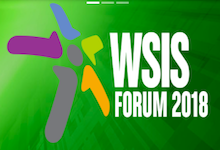Artificial intelligence and blockchain
19 Mar 2018 16:30h - 18:15h
Event report
[Read more session reports from the WSIS Forum 2018]
This session was focused on the use of artificial intelligence (AI) and blockchain by the Mexican government to the benefit of its citizens. Ms Yolanda Martinez Mancilla, national digital strategy coordinator for Mexico, moderated the session and started by stating that Mexico has an entrepreneurial environment, but inequality is still a challenge. Currently, the government embraces technology to reduce inequality. Recently, there have been constitutional reforms related to education and telecommunications. Access to the Internet is now a constitutional right and is guaranteed by the government. There is also an obligation to implement a universal digital policy.
An institutional framework was put in place, in order to define an agenda of digital transformation. Mexican authorities are aware of the benefits of technology: it boosts the economy, changes educational processes, improves universal health services, and promotes civic innovation. Connectivity has increased by 70% in the last five years. In addition, 71% of the Mexican population now has Internet coverage. 40 million people were connected in 2013, but in 2017, that number increased to 70 million. The country also has a legal framework to protect personal data and digital identity.
During recent years, the government has invested in providing different kinds of public information online, through the GovMex platform. The government has also used AI to improve the health system, although maternal death is still a problem in the country. The government now uses Prospera – an open access AI program – to track the health condition of pregnant women.
Ms Cristina Cardenas, general coordinator of @prendemx, addressed the use of AI in education. Between 2013 and 2015, the government delivered more than 2 million computers to schools. They realised that just delivering the technology was not enough to bridge the educational divide: citizens need to be trained to use it. So the project brought an increase in digital inclusion skills that students achieve by using the computers as an outcome indicator. They also focused on teacher training. AI was implemented to track daily what happens in the schools. One goal is to use big data to profile what teachers and students are doing, in order to improve the direction of public policy. Indicators should be created to measure digital skills, she said.
Mr Enzo Le Fevre, senior expert of the International Affairs Office and the AI Task Force at the Agency for Digital Italy, participated remotely. He stated that Italy has been engaged in the use of AI by the public administration. The purpose of the AI task force is to create more efficient services for the public administration. Italy has been following the similar examples as Mexico to understand AI as a solution for public administration. Blockchain, for instance, needs to be used by the public administration to improve bureaucracy. Nevertheless, the use of AI encompasses challenges related to ethics, the role of data and anonymization, and safe legal frameworks. He concluded by affirming that the impacts of the use of AI must be measured.
Mr Nicolás Pineda Salazar, technology adviser of the blockchain HackMX team’s initiative at the Digital Government Unit, was part of the hackathon conceived to enable solutions to improve public administration. The hackathon aimed to create a hybrid blockchain network with the participation of the government and non-governmental actors.
By Ana Corrêa
Related topics
Related event

